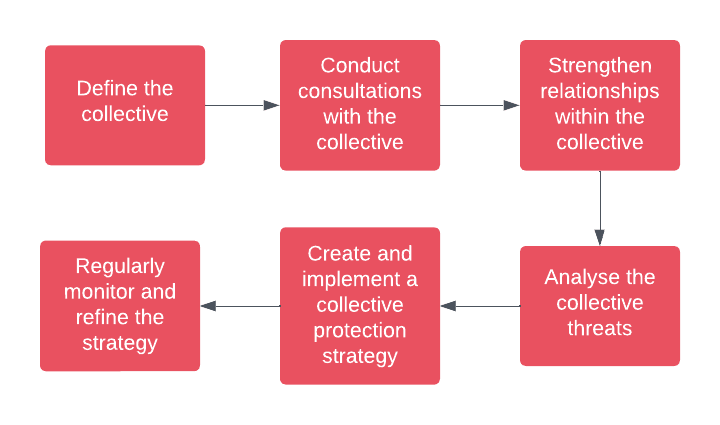
Collective protection is a way of approaching risk analysis and protection planning through the lens of a community, rather than through that of an individual defender. Collective protection recognises that the security of human rights defenders is interconnected with the security of those in their network, be it family, friends, colleagues, or neighbours. This main tenet is central to any collective protection strategy; however, the way that any individual strategy is developed will vary, and depend on the mission, profile, context, and needs of the particular defender and their network.
Collective protection is most-often associated with rural and indigenous communities in the Americas seeking to create and implement protection strategies adapted to their complex security needs. While it is true that many resources and studies on collective protection have come out of the Americas, and from land and water defenders in particular, diverse communities around the world have used similar strategies under different names. A common theme is that these strategies are designed to fit the needs of groups or communities at certain times and in response to threats that are not static. This means that collective protection measures regularly evolve to incorporate changes in communities or environments.
No one model of collective protection can be applied as a blanket solution. But by examining diverse examples, it is clear that there are common elements that can be used to structure thinking and planning around collective protection for any group. These include:
 The diversity of collective protection approaches across the world serves to demonstrate how any collective can begin to reflect on and design their own plan. For example, a group in Guatemala known as Peaceful Resistance La Puya has established a community protocol with criteria that guide their individual and collective resistance efforts. Their work locally includes direct action, legal battles, information sharing, and training; internationally, they build alliances and conduct advocacy. Through this, they have won protections and the suspension – at least for now – of mining operations. The principles of their community protocol include:
The diversity of collective protection approaches across the world serves to demonstrate how any collective can begin to reflect on and design their own plan. For example, a group in Guatemala known as Peaceful Resistance La Puya has established a community protocol with criteria that guide their individual and collective resistance efforts. Their work locally includes direct action, legal battles, information sharing, and training; internationally, they build alliances and conduct advocacy. Through this, they have won protections and the suspension – at least for now – of mining operations. The principles of their community protocol include:
- Not entering into dialogue with the companies operating in their area, but to demand that public institutions fulfil their functions and support the community.
- Ensuring inclusion and working to reduce internal inequalities linked to unbalanced power dynamics in their community.
- Developing collective processes where there is no single leader or spokesperson, so that all decisions are made with community input and no one person is distinguished from the rest.
Open Briefing has published a resource on collective protection for human rights defenders and allies wishing to know more about how to develop such strategies.
Collective protection is a living concept. Its main principles can be used to develop protection approaches for communities, organisations, and groups around the world. As human rights defenders often conduct their work in complex environments, with many different allies and adversaries, collective protection offers a way of working that addresses the root causes of human rights violations and offers ways to build more just and sustainable environments.
